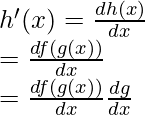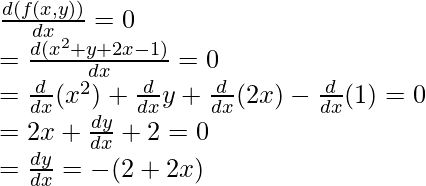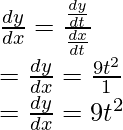高级差异化
导数用于衡量任何数量的变化率。这个过程称为分化。它可以被认为是微积分理论的基石。从几何上讲,任何函数在特定点的导数给出了函数在该点的切线的斜率。有许多方法可以求解和计算函数的导数。通常的方法是通过链式法则和幂法则进行计算。在某些情况下,函数变得过于复杂而无法计算。在这种情况下,必须遵循某些方法以简化计算。
衍生品
导数被定义为观察到的某些变量/数量的变化率。假设变量或数量由方程 f(x) 控制。该函数的导数表示为![]() 或 F(x)。必须牢记某些函数的导数。这些函数有助于简化导数的计算。下表显示了一些标准函数的派生值。
或 F(x)。必须牢记某些函数的导数。这些函数有助于简化导数的计算。下表显示了一些标准函数的派生值。Function Derivative sin(x) cos(x) cos(x) -sin(x) xn nxn-1 tan(x) sec2(x) cot(x) cosec2(x)
Sometimes, functions are made up of products or division of two or more functions. In such cases, the product and quotient rule is used. Consider a function h(x),
Product Rule: If h(x) = f(x).g(x)
h'(x) = f'(x)g(x) + f(x)g'(x)
Quotient Rule: If h(x) = f(x)/g(x)
![]()
链式法则
通常这些函数由两个或多个标准函数的组合组成。在这种情况下,找到导数的常用技术是不够的。在这种情况下,链式法则就派上用场了。将 f(x) 和 g(x) 视为两个可微函数,假设它们生成一个新函数h(x) = f(g(x)),它基本上是这些函数的组合。在这种情况下,可以应用如下所述的链式法则,

高级差异化
有些函数计算导数并不容易。在计算它们的导数之前,它需要一些代数操作。此类函数的示例是隐函数、参数函数、高阶导数和对数导数。所有这些函数都是由标准函数组成的,但是通过简单的链式法则或幂法则来解决它们是非常复杂的。
隐函数的导数
隐式函数是形式为 f(x, y) = 0 的函数。常见的函数是形式为 y = f(x)。这些函数是显式函数,因为 y 的定义被清楚地表达并以 x 表示。在隐函数中,x 和 y 之间的关系并不完全清楚。让我们以这种方法为例。
问题:求函数x 2 + y 2 = 4 的导数。
回答:
Notice that the given function is an implicit function,
x2 + y2 = 4
⇒ x2 + y2 – 4 = 0
This function is in the form of f(x, y) = 0.

参数函数的导数
在上面研究的函数中,函数只有两个变量,并且在它们之间定义了关系。通常,在某些函数中,两个变量之间的关系使用第三个变量来描述。这些函数称为参数函数。例如,x = f(t) 和 y = g(t) 在一个这样的函数中。在这个函数中,变量 x 和 y 是相对于变量“t”定义的。在这种情况下,计算 x 相对于 y 的变化率并不那么清楚。
问题:计算以下函数的导数。
x = t 2和 y = t 3 + 3。
回答:
This is an example of a parametric function. In this case, the derivatives are calculated with respect to the third variable for both the functions.
x = t2
Differentiating with respect to “t”,


Now these derivatives can be combined.

高阶导数
就像导数被定义为数量的变化率一样。同样,变化率的变化率也可以计算出来。这种衡量导数变化率的导数称为高阶导数。例如,位置的变化率由速度给出,加速度测量速度的变化率。对于函数f(x),
![]() 表示一阶导数。相似地,
表示一阶导数。相似地, ![]() 表示二阶导数,以此类推。
表示二阶导数,以此类推。
示例问题
问题 1:求 f(x) = x 3的二阶导数。
回答:
The first order derivative of this function is given by,
f(x) = x3
⇒ f'(x) = 3x2
Differentiating the function again,
f”(x) = 6x
问题 2:求给定函数的导数,
f(x) = sin(x)cos(x)
答案:
Given: f(x) = sin(x)cos(x)
The given function is the product of two functions, thus the product rule should be applied.
f(x) = h(x)g(x)
⇒f'(x) = h'(x)g(x) + h(x)g'(x)
Here, h(x) = sin(x) and g(x) = cos(x)
f'(x) = h'(x)g(x) + h(x)g'(x)
⇒ f'(x) = ![]()
⇒f'(x) = ![]()
问题 3:求给定函数的导数,
f(x) = xsin(x)
答案:
Given: f(x) = xcos(x)
The given function is the product of two functions, thus the product rule should be applied.
f(x) = h(x)g(x)
⇒f'(x) = h'(x)g(x) + h(x)g'(x)
Here, h(x) = x and g(x) = sin(x)
f'(x) = h'(x)g(x) + h(x)g'(x)
⇒ f'(x) = ![]()
⇒f'(x) = sin(x) + xcos(x)
问题 4:求函数x 2 + 2x + y = 1 的导数。
回答:
Notice that the given function is an implicit function,
x2 + 2x + y = 1.
⇒ x2 + 2x + y – 1 = 0
This function is in the form of f(x, y) = 0.

问题 5:计算以下函数的导数。
x = t + 5 和 y = 3t 3 + 6。
回答:
This is an example of a parametric function. In this case, the derivatives are calculated with respect to the third variable for both the functions.
x = t + 5
Differentiating with respect to “t”,


Now these derivatives can be combined.

问题 6:求 f(x) = e x + sin(x) 的三阶导数。
回答:
The first order derivative of this function is given by,
f(x) = ex + sin(x)
⇒ f'(x) = ex + cos(x)
Differentiating the function again,
f”(x) = ex – sin(x)
Differentiating the function again,
f”'(x) = ex – sin(x)